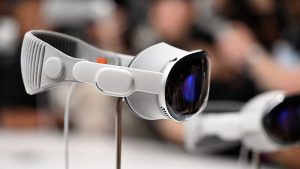As the technology world evolves, two tech giants, Apple and Meta, are embarking on a fierce race in the realm of spatial computing. The battleground? Virtual Reality (VR) and Augmented Reality (AR), collectively known as mixed reality.

Apple on Monday unveiled its first-ever virtual reality headset, challenging Facebook-owner Meta in a market that has yet to gain widespread consumer adoption.
Josh Edelson/AFP/Getty Images
1. Meta’s Early Move and Apple’s Strong Entry
Meta, formerly known as Facebook, has been investing heavily in the Metaverse for quite some time, with their Quest headset making a slow yet steady start in the market. However, despite Meta’s early move, the effect on its overall earnings is yet to be significant, as the company’s primary revenue still comes from ads on its social media platforms.
On the other hand, Apple, known for its premium and technologically advanced products, recently dropped a bombshell in the form of its Vision Pro headset. With a hefty price tag of $3,500, Apple’s new spatial computer has the tech world buzzing. While it’s too early to declare a clear winner, the high-quality hardware and the brand reputation of Apple give it an initial edge in this face-off.
2. The Question of Affordability and Market Coverage
While Apple’s Vision Pro boasts top-tier technology, its high price could potentially hinder widespread adoption. Conversely, Meta’s Quest headset, with its latest version priced at $500, offers a more budget-friendly alternative.
However, affordability does not necessarily translate into market dominance. The lower end of the market is already crowded with competitors, and the key to winning might lie in conquering the higher end of the spectrum first. Over time, as technology costs decrease, Apple could potentially introduce a more affordable version of their spatial computer.
3. The Pro Level Showdown
The high-end market is likely to be the primary battlefield in the early stages of the Metaverse’s rise. Meta’s move to the Pro level with Quest Pro, priced at $1,000, pales in comparison to Apple’s Vision Pro in terms of cost. However, the sticker price alone does not determine the winner. The truly immersive experience offered by these devices and their software capabilities will play a significant role in enticing users.

Meta teased its new Quest 3 headset days before Apple’s Vision Pro announcement.
From Meta
4. The Software Side of the Story
A pivotal point in this battle will be how well the software complements the hardware. Apple already has a reputation for seamlessly integrating its hardware and software, a factor that may give it an advantage. However, Meta is not far behind, and the coming years will reveal if it can match or surpass Apple in this aspect.
5. Stock Predictions: A Look at Apple and Meta
Currently, both Apple and Meta hold a “Strong Buy” rating on TipRanks, indicating a positive outlook from Wall Street analysts. However, the average AAPL stock price target of $192.93 implies just 1.2% upside potential, while the average META stock price target of $302.37 suggests a 4.1% upside potential.
6. The Privacy Factor and The Rebranding Saga
Apple’s stringent privacy changes previously posed a significant threat to Meta’s core advertising business, causing the social networking company to rebrand and shift its focus to virtual reality. Now, with Apple stepping into the same domain, the competition seems to be intensifying.
7. The Mixed Reality Market: A New Frontier
While both companies have a strong foothold in the tech industry, the mixed reality market is relatively new and unexplored. Despite Meta’s early entry, the mainstream adoption of VR and AR technology is yet to take off significantly. With Apple’s entry, the market dynamics are bound to change, leading to a full-blown mixed reality war.
8. The Challenge of Consumer Adoption
The success of both Apple’s Vision Pro and Meta’s Quest 3 ultimately depends on consumer adoption. While Apple boasts an existing loyal customer base and impressive hardware capabilities, Meta offers affordability and experience in the field. The question remains: can they convince their customers to embrace this new wave of technology?
9. Divergent Paths, Common Goal
Despite being in the same market, Apple and Meta seem to have different visions for their mixed reality products. While Apple focuses on creating a new iteration of the computer for individual use, Meta emphasizes gaming, enterprise, and social connections. However, the ultimate goal for both is to dominate the mixed reality market.
10. The Future of the Mixed Reality Market
The mixed reality market is burgeoning, and both companies will need to evolve their strategies to stay competitive. As the technology matures, we can expect to see a convergence of their offerings. However, for Meta to stand toe-to-toe with Apple, it might need to adopt an open-source strategy, similar to Android, to attract more device manufacturers to its platform.
In conclusion, the race between Apple and Meta in the mixed reality market is just beginning, with each company bringing its unique strengths to the table. The next few years will be crucial in determining who will dominate this new frontier of technology. The world watches with bated breath as these tech titans battle it out in the realm of the Metaverse.
